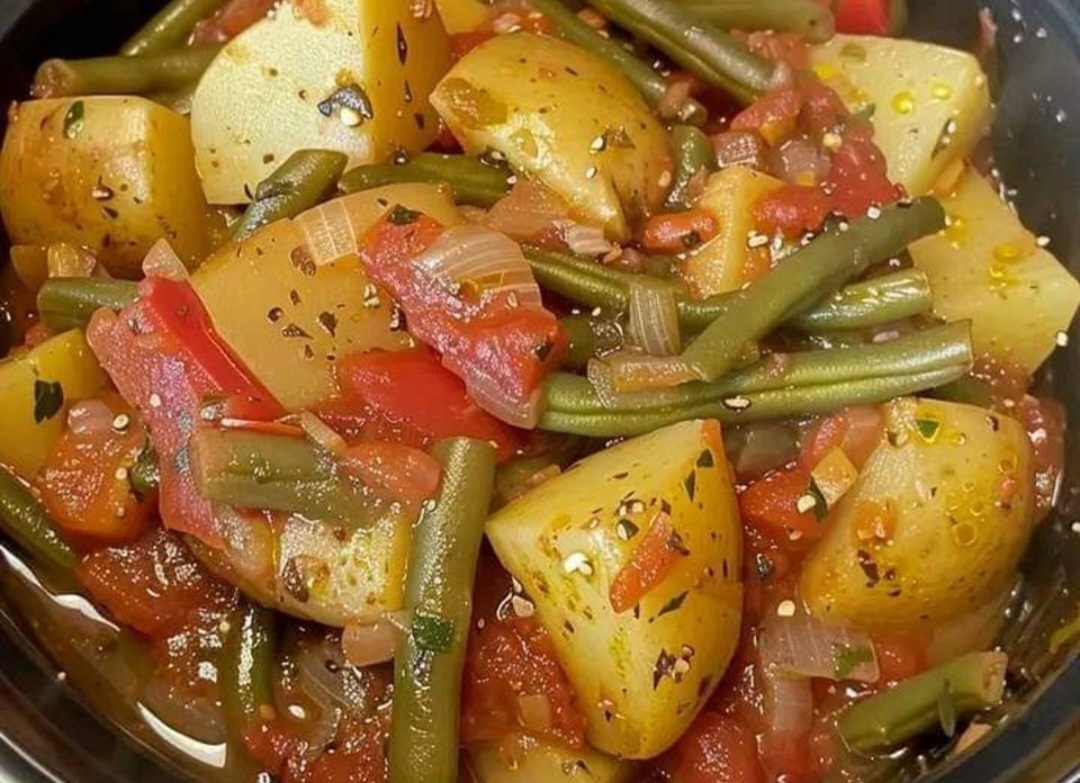Green beans, also called string beans or snap beans, are a popular, versatile vegetable known for their crisp texture and mild flavor.
They are harvested while still young and can be eaten raw or cooked.
Green beans are rich in vitamins A, C, and K, and provide dietary fiber, making them a nutritious addition to a balanced diet.
Common in many cuisines, they can be steamed, sautéed, or added to salads and stir-fries.
Fasolakia
green beans,
tomatoes,
potatoes (in my case today, a LOT of potatoes!),
onion,
olive oil,
a a little vinegar,
garlic,
fresh thyme,
vegetable bouillon,
sea salt,
pepper.
Cooked on high in a slow cooker for 6 hours.
Served with a splash of balsamic vinegar and lots of crusty bread.
Variations of Green Beans:
French Green Beans (Haricots Verts):
Thinner and more tender than regular green beans, these cook faster and have a more delicate flavor.
Yellow Wax Beans:
Similar in shape and size to green beans but with a yellow color. Their flavor is slightly milder.
Purple String Beans:
These beans turn green when cooked and offer a slightly sweeter taste.
Pole Beans:
A taller variety that grows on vines, producing longer and sometimes firmer beans.
Bush Beans:
These grow on low bushes and are common in home gardens.
They have a more classic green bean taste.
Cooking Tips:
Blanching for Crispness:
Blanch green beans by boiling them briefly and then plunging them into ice water.
This keeps them bright green and crisp, perfect for salads or sautés.
Roasting for Flavor:
Toss beans with olive oil, garlic, salt, and pepper, then roast at 400°F (200°C) for about 20 minutes for a caramelized, slightly crispy texture.
Stir-Frying:
Use high heat and a small amount of oil to stir-fry green beans with ginger, soy sauce, or sesame oil for a quick, flavorful dish.
Steaming:
For a simple side dish, steam green beans for 5-7 minutes until tender but still crisp, then toss with butter or lemon juice.
Enhance with Add-Ons:
Pair green beans with almonds, bacon, garlic, or fresh herbs like thyme or dill to boost flavor.
Storage Tips:
Store fresh green beans in a plastic bag in the refrigerator for up to a week.
Avoid washing them before storing, as excess moisture can cause spoilage.
These tips and variations can help you enjoy green beans in different styles, adding versatility to your meals.
To store green beans properly and extend their freshness, follow these tips:
In the Refrigerator:
Keep Unwashed:
Don’t wash green beans before storing, as moisture can speed up spoilage.
Use a Plastic Bag:
Place them in a perforated plastic bag or loosely wrap them in a damp paper towel and store in the crisper drawer of your fridge.
Storage Time:
Green beans will stay fresh for up to a week when stored properly.
Freezing Green Beans:
Blanch Before Freezing:
Blanch green beans first by boiling them for 2-3 minutes, then immediately plunging them into ice water to stop the cooking process.
This preserves their color, texture, and nutrients.
Dry and Pack:
After blanching and cooling, pat them dry and spread them on a baking sheet in a single layer to freeze.
Once frozen, transfer them to an airtight freezer bag or container.
Storage Time:
Frozen green beans can last for up to 12 months in the freezer.
Canning Green Beans:
Pressure Canning:
Green beans can be preserved through pressure canning, which allows them to be stored for up to a year without refrigeration.
This method requires special equipment like a pressure canner.
By following these methods, you can enjoy fresh or preserved green beans over a longer period while retaining their flavor and nutritional value.
Here’s the nutritional information for one cup (125 grams) of raw green beans:
Calories: 31
Protein: 2 grams
Carbohydrates: 7 grams
Fiber: 2.7 grams
Sugar: 3.3 grams
Fat: 0.2 grams
Water: 90%
Vitamin A: 15% of the Daily Value (DV)
Vitamin C: 27% of the DV
Vitamin K: 20% of the DV
Folate: 10% of the DV
Manganese: 8% of the DV
Iron: 6% of the DV
Magnesium: 6% of the DV
Key Nutritional Benefits:
Low in Calories:
Green beans are a low-calorie food, making them ideal for weight management.
High in Fiber:
They provide a good amount of dietary fiber, aiding digestion and promoting gut health.
Rich in Antioxidants:
Vitamins A and C help protect cells from oxidative stress.
Supports Bone Health:
The vitamin K content aids in bone formation and strength.
Good Source of Folate:
Essential for DNA production and cell growth, making green beans beneficial for pregnant women.
Green beans offer a well-rounded nutritional profile while being a light and versatile ingredient in various dishes.
